
© Stanley Roseman and Ronald Davis - All Rights Reserved
Visual imagery and website content may not be reproduced in any form whatsoever.
Visual imagery and website content may not be reproduced in any form whatsoever.
". . . the artist is an outstanding draughtsman and painter
to whom much recognition and success are due."
to whom much recognition and success are due."
- Walter Koschatzky
Director of the Albertina
Director of the Albertina
STANLEY ROSEMAN
You are also cordially invited to visit: www.stanleyroseman-monasticlife.com
Biography: Page 6
Continued
Continued
The Artist and his Model
Stanley Roseman and Father Xavier Szunyogh
in the Benedictine monk's room at the
Archabbey of Pannonhalma, Hungary, 1978.
in the Benedictine monk's room at the
Archabbey of Pannonhalma, Hungary, 1978.
Dom Bede, Portrait of a Benedictine Monk, St. Augustine's Abbey
5. Dom Bede,
Portrait of a Benedictine Monk
1980, St. Augustine's Abbey, England
Chalks on paper, 35 x 50 cm
Victoria and Albert Museum,
Portrait of a Benedictine Monk
1980, St. Augustine's Abbey, England
Chalks on paper, 35 x 50 cm
Victoria and Albert Museum,
London
The portrait of Dom Bede, drawn in a combination of chalks, was a gift to the Victoria and Albert Museum from Roseman and Davis in memory of their friend who passed away in 1993. Dom Bede Millard was a skilled craftsman in church vestments and contributed the chapter on 'Ecclesiastical Textiles' for the museum's exhibition catalogue on the architect Augustus Pugin. The catalogue, published in 1994, is dedicated to Dom Bede.
The museum's Senior Curator Susan Lambert, writes in November 1994 with enthusiasm and appreciation to Davis, who had initiated the gift:
"I am writing to thank you for your gift of the drawing of Dom Bede by Stanley Roseman. We are very pleased to be able to represent his work in this Collection. The identity of the sitter, Dom Bede, gives the drawing a particular significance since Dom Bede collaborated in the recent Pugin exhibition. The drawing is also an excellent example of modern portraiture. In terms of its subject, medium, and intrinsic quality the drawing fits extremely well into the V&A's collecting policy and is a notable acquisition."
- Susan Lambert
Senior Curator of Prints, Drawings, and Paintings
Victoria and Albert Museum, London
Senior Curator of Prints, Drawings, and Paintings
Victoria and Albert Museum, London
Portraiture holds an important place in Roseman's oeuvre. In the artist's early career in New York City in the 1970's, his work on the performing arts, and his travels to Lappland, Roseman painted and drew portraits. The artist's work in Benedictine, Cistercian, Trappist and Carthusian monasteries throughout Europe includes depictions of monks and nuns in prayer, work, and study and an extensive series of portrait paintings and drawings.
In a 1979 Sunday magazine cover story on the artist, Sweden's leading daily Aftonbladet, Stockholm, commends Roseman for creating portraits "artistically on a high level as well as accurately expressive of the human dimension.''
Drawing - the Foundation of the Visual Arts
12. Brother Stephen,
Portrait of a Trappist Monk
in Prayer, 1983
Bolton Abbey, Ireland
Chalks on paper, 50 x 35 cm
Graphische Sammlung Albertina, Vienna
Portrait of a Trappist Monk
in Prayer, 1983
Bolton Abbey, Ireland
Chalks on paper, 50 x 35 cm
Graphische Sammlung Albertina, Vienna
For Dom Sylvester's 100th birthday on June 11, 1986, Roseman and Davis made a gift of a portrait drawing by the artist of the Abbot Emeritus to Douai Abbey. In letter of appreciation, Dom Geoffrey Scott, librarian and archivist, who was to be elected Abbot in 1998, writes "on behalf of Fr Sylvester, Fr Abbot and the Community:
"We collected the drawing of Fr Sylvester yesterday afternoon and are delighted with it.
I'd not seen the drawing before and was struck by its power. It is very hard to thank you adequately for such a noble gift which will be a treasured possession of the community
through succeeding generations."
I'd not seen the drawing before and was struck by its power. It is very hard to thank you adequately for such a noble gift which will be a treasured possession of the community
through succeeding generations."
- Dom Geoffrey Scott, OSB
Abbot of Douai (1998 - )
Abbot of Douai (1998 - )
At the tenth-century Benedictine Archabbey of Pannonhalma, in the Gyor-Sopron region of western Hungary, Roseman, in 1978, drew the elderly, ascetic scholar Father Xavier Szunyogh. Father Xavier befriended Roseman and Davis, who occupied the room next to his in the cloister. The artist recounts in his journal:
Father Xavier, Archabbey of Pannonhalma
"Father Xavier's room was filled with books, the kind of room I appreciate being in. Father Xavier said he understood English as a written language but had had little practice in speaking English, so we spoke together in part through verbal communication and in part through the written word - that is, by jotting down on a notepad some of what we wanted to say to each other. . . . Father Xavier was a kind, gentle man whose company I very much enjoyed and who gave me the wonderful opportunity to draw him.''
The Musées Royaux des Beaux-Arts de Belgique - Art Moderne, Brussels, conserves Roseman's deeply felt portrait Father Xavier, 1978, (fig. 2).
Brilliant white highlights illuminate the elderly monk's lean visage and white hair and accentuate the collar on the distinctive Hungarian Benedictine habit. The reserved areas of gray paper impart a cool tonality to the skin tones complemented by warm shading on the monk's face. Roseman's vigorous modeling with chalks brings liveliness to the octogenarian's presence in the portrait, which poignantly reveals a sense of the man's younger, hardier years.
The Royal Museum of Fine Arts, Belgium, acquired the portrait with a drawing of a young hermit monk Brother Paolo, whom Roseman drew at the Hermitage of Camaldoli, secluded in the Apennines in Italy.
Dr. Henri Pauwels, Chief Curator of the Musées Royaux des Beaux-Arts de Belgique, Brussels, and Mrs. Phil Mertens, Chief Curator of Modern Art, write in a warm letter to Ronald Davis to acknowledge receipt of:
"the beautiful drawings by Stanley Roseman, Father Xavier
and The Young Hermit Paolo in Choir . . . .
and The Young Hermit Paolo in Choir . . . .
"We are very pleased that they will have the opportunity to find their place in the collection
of drawings of the Modern Art Department.''
of drawings of the Modern Art Department.''
- Dr. Henri Pauwels, Chief Curator
Musées Royaux des Beaux-Arts de Belgique
Musées Royaux des Beaux-Arts de Belgique
- Phil Mertens, Chief Curator of Modern Art
Musées Royaux des Beaux-Arts de Belgique
Musées Royaux des Beaux-Arts de Belgique
2. Father Xavier, 1978
Archabbey of Pannonhalma, Hungary
Chalks on paper, 48 x 33 cm
Musées Royaux des Beaux-Arts
de Belgique - Art Moderne,
Brussels
Archabbey of Pannonhalma, Hungary
Chalks on paper, 48 x 33 cm
Musées Royaux des Beaux-Arts
de Belgique - Art Moderne,
Brussels
The Curators thoughtfully add in their cordial letter:
PORTRAITS from the MONASTIC WORLD
On the artist's drawing board, next to his box of chalks,
is the portrait Father Xavier, (reproduced below, fig. 2),
Musées Royaux des Beaux-Arts de Belgique -
Art Moderne, Brussels
is the portrait Father Xavier, (reproduced below, fig. 2),
Musées Royaux des Beaux-Arts de Belgique -
Art Moderne, Brussels
The preceding page on the monastic life presents the oil on canvas painting Dom Henry, Portrait of a Benedictine Monk, 1978, St. Augustine's Abbey, England, acquired by the Chief Curator of the Museums of France for the Musée des Beaux-Arts, Rouen; and the portrait drawing Abbot Egidio Gavazzi, 1978, Abbey of Subiaco, Italy.
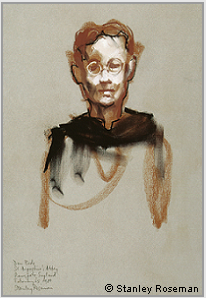
Roseman began his work on the monastic life in 1978 at St. Augustine's Abbey, England, as recounted on the previous page. Roseman and Davis returned to the monastery in 1980, commemorating the 1,500th anniversary of the birth of St. Benedict, Father of Western Monasticism. Dom Bede, Portrait of a Benedictine Monk, 1980, (fig. 5), was acquired for the Victoria and Albert Museum, London, by Susan Lambert, Senior Curator of Prints, Drawings, and Paintings, who praises the work as "an excellent example of modern portraiture."
Father Ian, Portrait of a Trappist Monk in Meditation,
Mount St. Bernard Abbey
Mount St. Bernard Abbey
Mount St. Bernard Abbey, secluded in a part of Charnwood Forest in Leicestershire, was the first Trappist monastery where Roseman painted and drew at the outset of his work in 1978. Roseman writes:
"The carpenter, a stocky, bearded monk named Ian, thoughtfully made his shop available to me and provided me with wood and tools with which to build stretchers for my canvases. Mentioning that my maternal grandfather had been a carpenter established an immediate rapport between Ian and me.''
3. Father Ian,
Portrait of a Trappist Monk in Meditation, 1978
Mount St. Bernard Abbey, England
Oil on canvas, 50 x 70 cm
Musée Ingres, Montauban
Portrait of a Trappist Monk in Meditation, 1978
Mount St. Bernard Abbey, England
Oil on canvas, 50 x 70 cm
Musée Ingres, Montauban
Father Ian, Portrait of a Trappist Monk in Meditation, (fig. 3), is conserved in the Musée Ingres, Montauban, whose renowned collection originated with an important bequest by Jean-Auguste-Dominique Ingres (1780-1867) of his paintings and drawings, as well as works by Italian and French old masters, to his hometown. The Museum's collection has since been augmented with works of modern art.
"Father Ian is for me an absolutely captivating work of art."
- Pierre Barousse, Curator
Musée Ingres, Montauban
Musée Ingres, Montauban
Roseman painted the superb portrait of Ian in the carpentry shop after the monk had finished his day's work. The striking mise-en-page with descriptive charcoal lines setting the composition onto the canvas and calligraphic brushstrokes rendering form and space are complemented by chiaroscuro modeling of the monk's strong facial features with dark hair and beard. Head and shoulders are silhouetted against a summary background of warm earth tones. Highlights on the white tunic and collar add brilliant accents to the portrait.
Roseman expresses serenity on the face of the Trappist monk, his right hand resting on his cheek and temple as he meditates at the end of his workday in anticipation of the monastery bell summoning the community to Vespers.
In letter to Davis, who introduced his colleague's work to the Musée Ingres, the distinguished Curator writes:
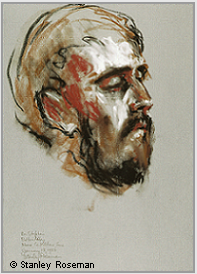
At the opening of the Albertina exhibitions Raphael in der Albertina and Stanley Roseman - Zeichnungen aus Klöstern on the evening of September 6, 1983, the museum's director Dr. Walter Koschatzky gave a formal address welcoming the President of Austria, the Burgomaster of Vienna, and guests, including members of the 25th International Congress of Art Historians, who had convened in Vienna. The Director of the Albertina warmly introduced the work of Roseman and praised him as "a master draughtsman.''
Roseman has devoted much of his professional life to drawing, considered the foundation of the visual arts by Giorgio Vasari, the sixteenth-century Florentine architect, painter, and author.[1] Although drawings have served as studies or drafts in preparation for compositions to be realized in another medium, drawings can be works complete unto themselves. The artist's signature on a drawing, as well as the date or an inscription as to the identity of the sitter or place, confirm the artist's intention in creating an autonomous work.[2] Roseman's drawings are autonomous works, which encompass a range of subjects, including portraits.
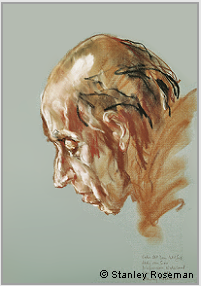
Portrait of the Abbot of Sion, Trappist Abbey of Sion
Abbot Adolfus van der Zeijden invited Roseman and Davis in 1984 to Sion Abbey in Diepenveen, located in the eastern province of Overijssel in the Netherlands. Greatly encouraging to the artist, the Abbot told Roseman that his work brings an awareness of contemplative life in the modern age and fosters understanding and ecumenicism between people of the Jewish and Christian faiths.
4. Portrait of the Abbot of Sion,
1984, Sion Abbey
The Netherlands
Chalks on paper, 50 x 35 cm
The Israel Museum, Jerusalem
1984, Sion Abbey
The Netherlands
Chalks on paper, 50 x 35 cm
The Israel Museum, Jerusalem
Recounting his sojourn at Sion Abbey, Roseman writes: "I asked the Abbot if I may include a portrait of him in my work on the monastic life. Abbot Adolfus told me that he was also the librarian and kindly invited me to join him at his desk in the library, where he worked and studied as well as where he did his spiritual reading.
"The library was a modest-sized room filled to capacity with books. I was pleased to be drawing there, for with my love of books, I often sought monastery libraries in which to draw as well as for reading and study."
Seated by the Abbot's desk at a window, Roseman drew the Abbot of Sion in profile, head inclined and eyes lowered as he concentrated on his spiritual reading. Chalks of earth pigments imbue the drawing with a warm tonality. Accents of black chalk delineate the fringe of hair complemented by white highlights on the monk's face and cranium. Roseman has drawn a moving portrait of a man dedicated to a life of contemplation and prayer.
The Israel Museum, Jerusalem, acquired in 1986 Portrait of the Abbot of Sion, (fig. 4). The Curator of Prints and Drawings Meira Perry-Lehmann warmly writes:
"I am very pleased to let you know that the drawing by Stanley Roseman
has arrived safely and is now in our department.
It is indeed a fine work and a welcome addition to our collection."
has arrived safely and is now in our department.
It is indeed a fine work and a welcome addition to our collection."
- Meira Perry-Lehmann
Curator of Prints and Drawings
The Israel Museum, Jerusalem
Curator of Prints and Drawings
The Israel Museum, Jerusalem
Brother Stephen, Portrait of a Trappist Monk in Prayer, Bolton Abbey
The artist drew Brother Stephen in choir at Bolton Abbey, County Kildare, during the artist's return to monasteries in Ireland in January of 1983. The drawing exemplifies Roseman's virtuosity in the use of the medium of chalk for portraiture. Bold contours and sculptural modeling of the masculine, facial features with white highlights and warm shading are in dramatic contrast to the young man's black mustache and beard. In this superb portrait of a Trappist monk in prayer, Roseman has created a drawing of great spiritual intensity.
The Trappist Abbey of St. Sixtus, in Flanders, was the first monastery on the Continent where Roseman drew. Returning to St. Sixtus over the years, the artist resumed drawing the monks at prayer, work, study, and at meals in the refectory. Roseman's portraits of members of the community include Brother Jos, 1981, (fig. 8).
The captivating portrait of Brother Jos, the gardener, has a Rubenesque quality in Roseman's painterly use of the chalks on ochre paper, which gives the composition a warm tonality. Red chalk brings vibrancy to the monk's fair complexion, and transparent passages of black chalk texture his wispy beard. White chalk adds luminous highlights on the face of the young, Flemish monk who wears a brown hat and turns to look directly out at the viewer.
Brother Jos was acquired in 1985 by the Chief Curator of the Museums of France, François Bergot, for the Musée des Beaux Arts, Rouen, of which he was the Director. The drawing entered the renowned Rouen Museum with a drawing that depicts a bespectacled, middle-aged, English Benedictine monk Father Gregory at tea at St. Augustine's Abbey in 1980. In a cordial letter to Davis, who introduced his colleague's work to the museum, the Chief Curator of the Museums of France praises the
"two very beautiful drawings by Stanley Roseman."
- François Bergot
Chief Curator of the Museums of France
Director, Musée des Beaux-Arts, Rouen
Chief Curator of the Museums of France
Director, Musée des Beaux-Arts, Rouen
8. Brother Jos, 1981
St. Sixtus Abbey, Belgium
Chalks on paper, 50 x 35 cm
St. Sixtus Abbey, Belgium
Chalks on paper, 50 x 35 cm
Musée des Beaux-Arts, Rouen
Brother Jos, St. Sixtus Abbey
11. Dom Sylvester Mooney,
Abbot Emeritus
1984, Douai Abbey, England
Chalks on paper, 50 x 35 cm
British Museum, London
Abbot Emeritus
1984, Douai Abbey, England
Chalks on paper, 50 x 35 cm
British Museum, London
Although Dom Sylvester was advanced in years, the erudite abbot was lucid of mind and a vital presence in the Community. He participated in the Divine Office in choir and took his meals with the monks. In a gracious gesture, the Abbot Emeritus honored Roseman by seating the artist next to him at his table in the refectory.
Dom Sylvester invited Roseman to draw him in his room, and over a number of days, the artist drew several excellent portraits of the Abbot Emeritus.
In the present work, drawn with a combination of chalks on gray paper, the artist renders the face of the elderly abbot with white highlights and warm shading. Several strokes of black chalk define the monk's black scapula with hood lowered. Roseman's superb portrait has an immediacy of lively expression as Dom Sylvester looks directly out at the viewer.
The British Museum acquired in 1996 Roseman drawings on the monastic life and the dance. The Deputy Director Jean Rankine writes in her cordial letter to the artist: ''At their last meeting the Trustees of the British Museum had before them a report of your gift to the Department of Prints and Drawings of three drawings by yourself: Mother Mary Imelda, Abbess of Glencairn, Ireland (1978); Dom Sylvester Mooney, Abbot Emeritus, Douai Abbey, Reading (1984); and Kader Belarbi, Ballet de l'Opéra de Paris, 'Petrouchka' (1994).
''I am directed by the Trustees to convey to you this expression of
their best thanks for these most welcome additions to their collections.''
their best thanks for these most welcome additions to their collections.''
- Jean Rankine, Deputy Director
British Museum, London
British Museum, London
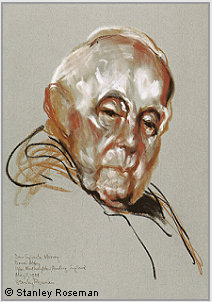
Dom Sylvester Mooney, Abbot Emeritus, Douai Abbey
The Graphische Sammlung Albertina conserves four portrait drawings by Roseman, including the present work Brother Stephen, Portrait of a Trappist Monk in Prayer, (fig. 12).
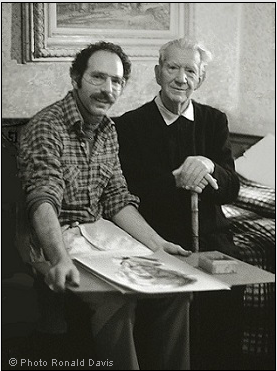
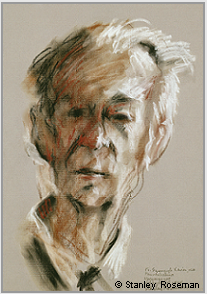
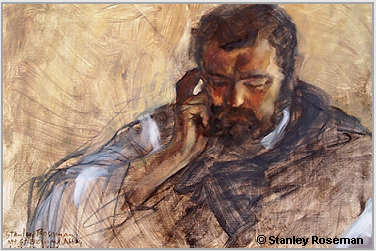
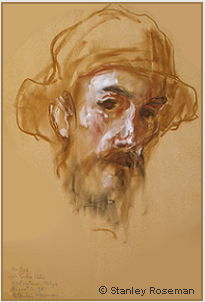
1. Giorgio Vasari , Vasari on Technique (New York: Dover Publications, Inc., 1960), p. 205.
2. Peter Schatborn, Rembrandt: the Master& his Workshop: Drawings & Etchings (New Haven: Yale University Press, 1991), p. 10.
3. Leonardo to Van Gogh: Master Drawings from Budapest, 1985, was the first American exhibition of drawings
from the Szépművészeti Múzeum. The exhibition was organized by Dr. Ferenc Merényi, Director of the Museum;
Dr. Klára Garas, Director Emeritus; and J. Carter Brown, Director of the National Gallery of Art in Washington, D.C.,
where the exhibition opened its American tour.
4. The Encyclopaedia of Oxford, ed. Christopher Hibbert (London: Macmillan, 1988), p. 40.
2. Peter Schatborn, Rembrandt: the Master& his Workshop: Drawings & Etchings (New Haven: Yale University Press, 1991), p. 10.
3. Leonardo to Van Gogh: Master Drawings from Budapest, 1985, was the first American exhibition of drawings
from the Szépművészeti Múzeum. The exhibition was organized by Dr. Ferenc Merényi, Director of the Museum;
Dr. Klára Garas, Director Emeritus; and J. Carter Brown, Director of the National Gallery of Art in Washington, D.C.,
where the exhibition opened its American tour.
4. The Encyclopaedia of Oxford, ed. Christopher Hibbert (London: Macmillan, 1988), p. 40.
6. Sister Immaculata, 1983
St. Mary's Abbey, Ireland
Chalks on paper, 50 x 35 cm
Teylers Museum, Haarlem
St. Mary's Abbey, Ireland
Chalks on paper, 50 x 35 cm
Teylers Museum, Haarlem
NRC Handelsblad, Rotterdam-Amsterdam, published an enthusiastic reportage on Roseman's work on the monastic life. The leading Dutch newspaper states: ''This is work that reaches impressive heights, especially in the portraits of these men and women.''
The portrait of Sister Immaculata in meditation and prayer is masterly rendered in the medium of chalk. With chiaroscuro modeling Roseman creates a harmony of cool skin tones and warm shading of the elderly woman's face with deep set eyes and a peaceful countenance.
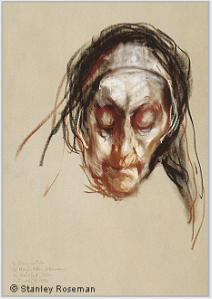
The Museum's Director writes on behalf of himself and his Keeper of Prints and Drawings, Carel van Tuyll, to the artist's colleague Ronald Davis:
''The quality of the drawings of which you sent us slides is such that they would form a most welcome addition to the arts collection of the museum. . . . Moreover, we felt that the 'Rembrandtesque' (if one may call them so) qualities of the portrait of Sister Immaculata in particular would take on an added dimension in the context of the Dutch drawings in the Teyler Collection.''
- Eric Ebbinge
Director, Teylers Museum
Director, Teylers Museum
Sister Immaculata and a portrait of a Benedictine monk, Dom Philippe, 1979, Abbey of Fleury, France, were acquired by the Teyler Museum in the Netherlands in 1986. The Teyler Museum is renowned for its master drawings from the Italian Renaissance, including sheets by Michelangelo and Raphael, and the seventeenth-century Dutch school, notably drawings by Rembrandt.
1. The Monastic Life
2. Portraits from the Monastic World
3. An Audience with Pope John Paul II
2. Portraits from the Monastic World
3. An Audience with Pope John Paul II
Roseman drew the impressive portrait of the Trappist nun Sister Immaculata, St. Mary's Abbey, Glencairn, when he and Davis returned to monasteries in Ireland in 1983, (fig. 6). In acquiring the work for the Teyler Museum in the Netherlands, the Director Eric Ebbinge, refers to the portrait as "Rembrandtesque"
St. Mary's Abbey, County Waterford, was the first convent in which the artist drew in 1978. Abbess Mary Imelda had written a gracious letter of invitation to Roseman and Davis: ''you will be very welcome.'' Due to the extraordinary circumstances regarding the artist's work, Roseman was given the unique privilege of being invited inside the cloister to draw the Trappist nuns.
Sister Immaculata, Portrait of a Trappist Nun in Prayer
St. Mary's Abbey, Glencairn
St. Mary's Abbey, Glencairn
The Szépművészeti Múzeum (Museum of Fine Arts), Budapest, which conserves a renowned collection of master drawings,[3] acquired the portrait Brother Péter Márton, (fig. 9), and an equally fine portrait of the Benedictine monk.
"Brother Péter Márton was the first monk I drew at Pannonhalma," recounts Roseman. "I am grateful to him for providing me with the opportunity to begin my work in the monastery, more so as the kindly monk had the name of St. Martin of Tours, early monastic leader born in Pannonia c.316. I drew Brother Péter Márton in his room on two occasions and appreciated the time he gave me.
Dr. Ferenc Merényi, Director of the Szépművészeti Múzeum, writes in 1987 to Davis to thank him for offering a gift of Roseman's work: "We would be very pleased to have two drawings from Pannonhalma by Stanley Roseman, the ones representing Brother Péter Márton."
In letter acknowledging receipt of the drawings, the Deputy Director Dr. Miklós Szabó, art historian, archaeologist of Celtic and classical Greek antiquity, and university professor, writes to express the Museum's gratitude for "the two beautiful portraits."
9. Brother Péter Márton, 1978
Archabbey of Pannonhalma, Hungary
Chalks on paper, 48 x 33 cm
Szépművészeti Múzeum, Budapest
Archabbey of Pannonhalma, Hungary
Chalks on paper, 48 x 33 cm
Szépművészeti Múzeum, Budapest
Brother Péter Márton, Archabbey of Pannonhalma
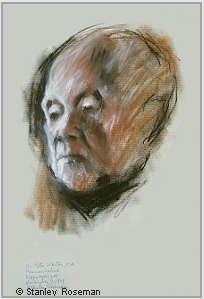
A strong, northern light illuminates the face of the ascetic monk absorbed in thought. The artist renders the man's facial features with fine gradations of light and shade, or sfumato, complemented by linear description and warm tonal passages. The monk's high, black collar and the dark background that follow the contours of the face and forehead set the portrait in pictorial space. Roseman has drawn an intimate portrait of Brother Péter Márton, who has followed an ascetic, contemplative life inspired by the Saint born in the region of Pannonia.
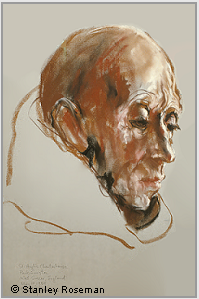
Portrait of a Carthusian Monk, St. Hugh's Charterhouse, Parkminster
Portrait of a Carthusian Monk, (fig. 7), was acquired in 1986 by the Mead Art Museum, Amherst, Massachusetts, the state in which the artist was born. The Amherst College Museum's collection is noted for works on paper by American artists. The portrait entered the collection with Roseman's drawing from the Benedictine Abbey of St. Stephan, Augsburg. "I am very pleased with the drawings,'' writes the Museum's Director Frank Trapp in acknowledging "this fine gift to the collection of Amherst College.''
Dom Bede is depicted in three-quarter profile with warm shading enhanced by white highlights on the face of the Carthusian monk. A few strokes of bistre chalk define the monk's hood lowered on his shoulders. With chiaroscuro modeling of the chalks complemented by fine linear description, Roseman drew a superb portrait that conveys the asceticism and inner being of a man who had dedicated his many years to the contemplative life.
7. Portrait of a Carthusian Monk
1984, St. Hugh's Charterhouse
Parkminster, England
Chalks on paper, 50 x 35 cm
Mead Art Museum, Amherst College
Amherst, Massachusetts
1984, St. Hugh's Charterhouse
Parkminster, England
Chalks on paper, 50 x 35 cm
Mead Art Museum, Amherst College
Amherst, Massachusetts
Dom Bede, Assistant Procurator for thirty years, befriended the artist and his colleague on their first sojourn at Parkminster. The kindly monk had thoughtfully brought them to the library. The artist recalls: "Dom Bede showed us wonderful rare books and manuscripts, including a 12th-century Gradual containing music for the Mass, and assisted Ronald and me in our studies on the Carthusian Order."
The Carthusian Order, founded in 1084, provides for the solitary life of the hermit within the context of a monastic community. St. Hugh's Charterhouse, Parkminster, West Sussex, is the only Carthusian monastery in the British Isles today. On the 900th anniversary of the Carthusian Order, Roseman and Davis received an invitation from Prior Dom Bernard to return to Parkminster, where they had sojourned the year before.
10. Brother Abraham, 1978
Tyniec Abbey, Poland
Chalks on paper, 48 x 33 cm
Ashmolean Museum, Oxford
Tyniec Abbey, Poland
Chalks on paper, 48 x 33 cm
Ashmolean Museum, Oxford
- Dr. Kenneth Garlick, Keeper of Western Art
Ashmolean Museum, Oxford
Ashmolean Museum, Oxford
The Encyclopaedia of Oxford, edited by Oxford historian Christopher Hibbert, notes the Ashmolean Museum acquired the work of Stanley Roseman.[4]
Brother Abraham, Tyniec Abbey
The Benedictine Abbey of Tyniec, founded in the eleventh century, is located along the River Vistula and some twelve kilometers from Krakow. In November 1978 Prior Dominic Michalowski warmly welcomed Roseman and Davis and thanked them for making the journey to Poland to include Tyniec in the artist's work.
In correspondence with Ronald Davis, the Keeper also wrote in appreciation for the acquisition of "a fine drawing of Brother Abraham."
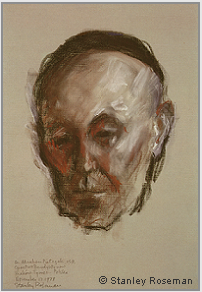
Brother Abraham, (fig. 10), drawn in chalks on gray paper, has a sculptural quality in the depiction of the Polish monk's face and broad, high forehead. He wears a black skullcap. Sanguine chalk enhances the ruddy complexion of the monk who worked at various jobs out-of-doors around the monastery. With chiaroscuro modeling, Roseman complements cool light and warm shading in the portrait of Brother Abraham, having kindly given of his time to the artist.
The Ashmolean Museum, Oxford, housing a renowned collection of master drawings, conserves the portrait of the Benedictine monk. Dr. Kenneth Garlick, Keeper of the Department of Western Art, acquired the work in 1979 and made a second acquisition in 1982 of Roseman's "fine drawing'' of a Carthusian monk.
Roseman was invited in 1984 to the Benedictine Abbey of Douai in Reading to draw Abbot Emeritus Dom Sylvester Mooney, (fig. 11, below), one of the most revered churchmen in Great Britain. Dom Sylvester had been Abbot for forty years at the time of his retirement in 1969. When Roseman drew him, Dom Sylvester was ninety-eight years old and the oldest living monk in the Western Church.